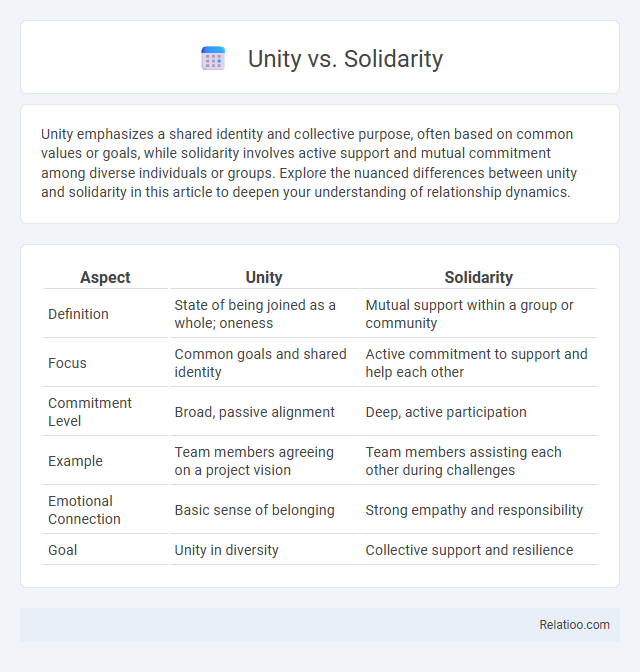Unity emphasizes a shared identity and collective purpose, often based on common values or goals, while solidarity involves active support and mutual commitment among diverse individuals or groups. Explore the nuanced differences between unity and solidarity in this article to deepen your understanding of relationship dynamics.
Table of Comparison
| Aspect | Unity | Solidarity |
|---|---|---|
| Definition | State of being joined as a whole; oneness | Mutual support within a group or community |
| Focus | Common goals and shared identity | Active commitment to support and help each other |
| Commitment Level | Broad, passive alignment | Deep, active participation |
| Example | Team members agreeing on a project vision | Team members assisting each other during challenges |
| Emotional Connection | Basic sense of belonging | Strong empathy and responsibility |
| Goal | Unity in diversity | Collective support and resilience |
Defining Unity and Solidarity
Unity represents a state of being united or joined as a whole, emphasizing harmony and agreement among individuals or groups. Solidarity, in contrast, involves mutual support and shared responsibilities, often arising from common interests or goals despite differences. While unity focuses on collective oneness, solidarity highlights active commitment and collaboration within that unified group.
Historical Contexts of Unity and Solidarity
Historical contexts of unity often highlight the unification of diverse groups under a common political or cultural identity, such as the unification of Germany in the 19th century, whereas solidarity emphasizes mutual support within social movements, exemplified by the Polish Solidarity movement of the 1980s that fought against authoritarianism. Unity typically involves formal political or national structures consolidating power, while solidarity arises from grassroots collective action motivated by shared interests or struggles. Understanding these distinctions reveals how unity shapes state-building processes, and solidarity fosters social cohesion in moments of resistance.
Core Differences Between Unity and Solidarity
Unity refers to a state of being joined or linked as a whole, emphasizing uniformity and harmony among members, often involving shared goals and values. Solidarity highlights mutual support and commitment within a group, especially during challenges, focusing on collective strength despite individual differences. The core difference lies in unity's focus on cohesion and oneness, while solidarity centers on active support and interconnectedness amid diversity.
The Role of Unity in Social Movements
Unity in social movements creates a cohesive collective identity that strengthens resistance against oppression and drives social change. Solidarity enhances this by fostering mutual support among diverse groups, but without foundational unity, efforts can become fragmented and less effective. The role of unity is pivotal in mobilizing resources, sustaining momentum, and achieving common goals in social activism.
The Power of Solidarity in Community Building
Solidarity fosters a deep sense of connection among community members, enabling collective action that achieves shared goals more effectively than mere unity, which can sometimes lack genuine commitment. Your community's strength grows when individuals unite through solidarity, emphasizing mutual support and common purpose rather than just being together. This powerful bond transforms group efforts into sustainable social change and resilience.
Unity vs Solidarity in Political Contexts
Unity in political contexts refers to the consolidation of individuals or groups under a shared identity or purpose, often emphasizing homogeneity and collective strength. Solidarity focuses on mutual support and agreement among diverse groups, promoting cooperation despite differing interests or backgrounds. Your understanding of these concepts shapes how movements mobilize, balancing the desire for uniformity through unity against the inclusiveness fostered by solidarity.
Challenges in Achieving Unity and Solidarity
Achieving unity and solidarity faces challenges such as diverse individual interests, cultural differences, and communication barriers that hinder collective action. Your efforts must address trust-building and conflict resolution to overcome fragmentation within groups. Effective leadership and inclusive dialogue are critical in aligning goals to foster genuine solidarity and sustained unity.
Case Studies: Unity and Solidarity in Action
Unity and solidarity both play crucial roles in social movements, with unity emphasizing a shared purpose and solidarity highlighting mutual support among diverse groups. Case studies such as the Civil Rights Movement demonstrate unity through common goals, while labor union campaigns exemplify solidarity by fostering collective action despite different individual interests. Understanding your role in these dynamics can enhance the effectiveness of collaborative efforts and drive meaningful change.
Impact on Organizational Success
Unity fosters a consistent vision and aligned goals, driving efficient decision-making and collaboration in your organization. Solidarity builds a strong sense of support and shared purpose among employees, enhancing morale and resilience during challenges. Together, unity and solidarity amplify organizational success by improving communication, trust, and commitment to collective objectives.
Choosing Between Unity and Solidarity
Choosing between unity and solidarity depends on the nature of Your group's goals and values; unity emphasizes uniformity and consensus, often prioritizing agreement over diversity of thought. Solidarity focuses on mutual support and shared commitment despite differences, fostering collaboration through recognition of diverse perspectives. Understanding these distinctions helps determine whether Your situation requires cohesive uniformity or empowered cooperation through shared purpose.

Infographic: Unity vs Solidarity
 relatioo.com
relatioo.com